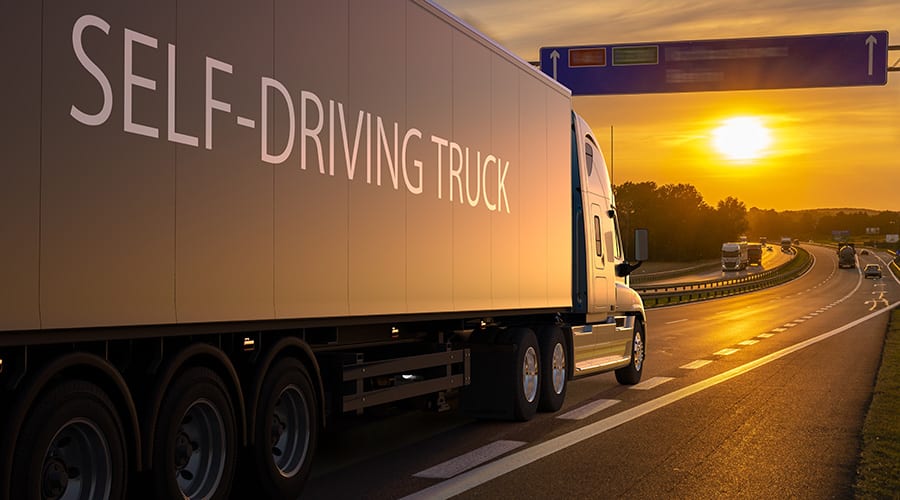Speculation abounds about when we might experience self-driving cars, as tech startups tout this new technology to revolutionize transportation.
A different transportation revolution, however, might overtake self-driving cars, and that would be self-driving trucks.
With the potential to slash transportation costs, the advent of self-driving trucks could have a significant impact on industries that utilize truck fleets and rely on trucks to conduct business, including scrap metal recycling businesses. Industry observers are now evaluating how and when such a move could become reality.
Self-driving trucks versus self-driving cars
Tech companies launching driverless vehicles have pulled ahead with driverless trucks because of their adaptability to the technology. Primarily, most trucking is done along fixed routes, with commercial entities repeatedly mapping out the same trip.
Trucking is mostly over highways, versus crowded city streets which are harder to maneuver. Trucks are physically larger than cars, giving the vehicles more space for the computers needed to drive them. The size of trucks also gives them an improved field of view for sensors like cameras which can be mounted higher off the ground.
The technology behind driverless vehicles, be they cars or trucks, works roughly in the same manner. A vehicle is equipped with sensors such as cameras, lidar and radar. These sensors feed data into an on- board computer which controls the vehicle, using skills the vehicle has “learned” through training and simulation.
On the road today
A handful of startup companies are pursuing autonomous trucking, known as AT, and are currently experimenting with trial runs. In most cases, these trial runs work best for industry segments in which there are long hauls in wide open spaces. For example, self-driving tech company TuSimple last spring transported a load of watermelons from Nogales, Arizona, to Oklahoma City, Oklahoma, using an autonomous driving system for more than 80 percent of the drive. For this route, a human driver drove the first 60 miles. Another human driver drove the last 200 miles, from Dallas, Texas, to the destination. In between, what’s known as the “middle mile,” the truck was “driven” by its computer, but a human “safety driver” was on board the entire time.
Human safety drivers are on board for mechanical or emergency reasons, to address a break down or an incident involving law enforcement. Because the human safety operator is not driving the truck, the truck does not have to pull over for rest stops, work breaks or driver sleeping. For this reason, the watermelon delivery which normally takes 24 hours and 6 minutes, took about 14 hours. The result was watermelons arriving one day earlier and fresher at their destination.
AT companies forecast this as the model: having drivers take the first and last city miles, with an autonomous system taking the middle highways miles. One could envision an AT delivering a load to a depot near a highway and having a scrap yard driver or trucking contractor employee drive the load the last few miles to a scrap yard for loading and shipment.
Advantages and disadvantages
At first glance, an autonomous truck sounds like a potential safety hazard. A large heavy vehicle moving at highway speeds among cars without a human driver sounds like an accident waiting to happen. Proponents of the technology, though, say it provides huge safety improvements. Unlike human drivers, a computer will not get distracted, fall asleep, consume alcohol or drugs, speed, drift from their lane or need to slam on the brakes. (Sensor technology sees down the road more than 1000 meters, much farther than a person can see, enabling the AT to start to brake and slow down sooner.)
AT companies also say the technology will increase fuel efficiency, therefore cutting fuel costs and reducing emissions. Better fuel efficiency can be achieved because computer driven trucks drive at a constant speed and are not as frequently braking, stopping and re-starting. Transporting times are cut dramatically with AT because there is no need to take breaks. A recent BBC article reported that while a human-driven truck takes five days to drive from New York to Los Angeles, an AT takes 48 hours. These safety improvements and fuel and time efficiencies all translate into significant savings.
A potential significant disadvantage is the loss of jobs for truck drivers. Advocates say currently, though, there is a shortage of truck drivers. According to the American Trucking Association, that shortage is about 51,000 truck drivers today. AT technology can help fill this gap. Additionally, drivers will still be needed for at least the next several years to drive the first and last segments of most routes and to work as on-board safety drivers.
Outlook for the future
Government regulation of driverless trucks has not kept pace with the state of the industry. Right now there are no federal regulations in place for AT. According to a recent Forbes article, 24 states allow some degree of autonomous trucking, but the laws vary from state to state. According to the Wall Street Journal, the Federal Motor Carrier Safety Administration has proposed writing rules regarding AT but that process would likely take a few years. This has not stopped the startups from forging ahead with the technology.
The Society of Automotive Engineering has established six levels of self-driving technology, from zero to five. Zero represents a vehicle with only manual control, while level five would be a vehicle with total automation. Companies like TuSimple hope to achieve level four automation by 2024. At that level, an AT would be able to operate without a human on board under limited conditions, such as time of day, route chosen and weather conditions.
Once a higher level of automation is achieved, most AT companies envision that they will sell their trucking technology as a service, like a subscription, to freight operators. It will be sometime thereafter when individual truck manufacturers could consider selling these vehicles to the public. So, while AT technology is in the works, it is not right around the corner, and appears to be at least a few years down the road.
ScrapWare Corp., of Rockville, MD, has been providing software to the scrap metal recycling industry for over 30 years. ScrapWare uses an Oracle database to provide a cloud-based software solution to manage all aspects of a recycling business. With numerous modules, extensive technical support, remote installation and online training, ScrapWare helps recycling companies with compliance, efficiency and profitability. Check out ScrapWare’s website, read the user testimonials, and see its offerings for your recycling software solution.

